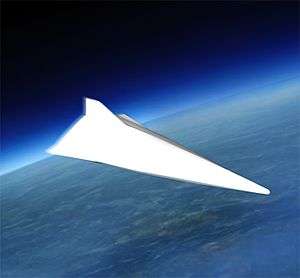WU-14
| WU-14/DF-ZF | |
|---|---|
 | |
| One of the configurations of Chinese HGVs | |
| Role | Experimental aircraft |
| National origin | People's Republic of China |
| First flight | 9 January 2014 |
|
| |
WU-14[1][2] was the Pentagon's code name for a Chinese experimental hypersonic glide vehicle (HGV), which is now called the DF-ZF.[3]
Testing
The DF-ZF (previously designated as the WU-14) is a hypersonic missile delivery vehicle that has been flight-tested by the Chinese seven times, on : 9 January, 7 August and 2 December 2014; 7 June and 27 November 2015[3] and April 2016.[4]
The Chinese Defense Ministry confirmed its January 2014 test and said the test was "scientific" in nature, although it was widely viewed as part of a broader Chinese military build-up.[5] The August 2014 test was described as a failure by U.S. officials; the other tests were apparently successful.[3][4] All the test launches were performed at the Taiyuan Satellite Launch Center in Shanxi Province, the main long-range missile testing center for the People's Liberation Army.[3][4]
Capabilities and design
"The DF-ZF HGV can allegedly reach speeds between Mach 5 and Mach 10" (i.e., between 6,173 km/hour (3,836 mph) and 12,359 km/hour (7,680 mph).[4] According to Jane's Defence Weekly and others, the DF-ZF could be used for nuclear weapons delivery but could also be used to perform precision-strike conventional missions (for example, next-generation anti-ship ballistic missiles), which could penetrate "the layered air defenses of a U.S. carrier strike group."[3][4]
The DF-ZF is a dangerous weapon because hypersonic glider vehicles are "almost impossible to intercept by conventional missile defense systems, which track incoming objects via satellite sensors and ground and sea radar."[4] According to some sources,[4] one weakness in the Chinese DF-ZF program, however, is a lack of high-performance computing power, which stymies design. In despite of such reports, the program keeps going ahead with seven launches, most of them successful, as of 2016.[3]
The HGV is intended to be less susceptible to anti-ballistic missile countermeasures than conventional reentry vehicles (RVs). Normal RVs descend through the atmosphere on a predictable ballistic trajectory - their high speeds makes intercepting them extremely difficult. By the late 1980s, however, several countries began to develop interceptor missiles designed to destroy ballistic RVs. A hypersonic glider like the HGV could pull-up after reentering the atmosphere and approach its target in a relatively flat glide, lessening the time it can be detected, fired at, or reengaged if the initial attack failed. Gliding makes it more maneuverable and extends its range.[6]
A vehicle like the WU-14 could be fitted to various Chinese ballistic missiles, such as the DF-21 medium-range missile (extending range from 2,000 to 3,000 km (1,200 to 1,900 mi)), and the DF-31 intercontinental ballistic missiles (extending range from 8,000 to 12,000 km (5,000 to 7,500 mi). Analysts suspect that the WU-14 will first be used in shorter-range roles as an anti-ship missile and for other tactical purposes to address the problem of hitting a moving target with a ballistic missile. Long-term goals may include deterrence of U.S. missile capabilities with the prospect of strategic bombardment against America, or other countries. With conventional interceptor missiles having difficulty against targets with late detection and maneuvering while traveling faster than Mach 5 (the WU-14 reenters the atmosphere at Mach 10), the U.S. may place more importance on developing directed-energy weapons as a countermeasure.[6]
The HGV stays within the stratosphere after reentry and pull-up, and glides through the air. Although that creates more drag, warheads fly further than they would on a higher trajectory through space, and are too low to be intercepted by exo-atmospheric kill vehicles. The tradeoff is that warheads have less speed and altitude as they near the target, making them vulnerable to lower-tier interceptors.[7] For example the mach 10 Sprint missile and its US derivatives and the mach 17 Russian 53T6, ABM-3 Gazelle. Other potential counter-hypersonic interception measures may involve laser or rail gun technologies.[8]
See also
- Hypersonic glide vehicle
- Hypersonic Technology Vehicle 2 and Advanced Hypersonic Weapon – a similar US test vehicle and warhead
- Yu-71 – a similar Russian test vehicle (warhead)
- Hypersonic Technology Demonstrator Vehicle - an Indian hypersonic vehicle under development
- U.S. DARPA Falcon Project - Prompt Global Strike - Advanced Hypersonic Weapon
- Rockwell X-30, 1990-1993 project for SSTO prototype
- Boeing X-51
- Second Artillery Corps
References
- ↑ http://www.popsci.com/blog-network/eastern-arsenal/hypersonic-gliders-scramjets-and-even-faster-things-coming-chinas
- ↑ http://www.spacedaily.com/reports/Chinas_Hypersonic_Glide_Vehicle_A_Threat_to_the_United_States_999.html
- 1 2 3 4 5 6 Richard D Fisher Jr, US officials confirm sixth Chinese hypersonic manoeuvring strike vehicle test, IHS Jane's Defence Weekly (November 27, 2015).
- 1 2 3 4 5 6 7 Franz-Stefan Gady, China Tests New Weapon Capable of Breaching US Missile Defense Systems, The Diplomat (April 28, 2016).
- ↑ "China confirms hypersonic missile carrier test". Reuters. January 16, 2014.
- 1 2 U.S. Navy Sees Chinese HGV as Part of Wider Threat, Aviation Week, 27 January 2014
- ↑ Introducing the Ballistic Missile Defense Ship - Aviation Week 11 April 2014
- ↑ U.S., China in Race to Develop Hypersonic Weapons - Nationaldefensemagazine.org, 27 August 2014